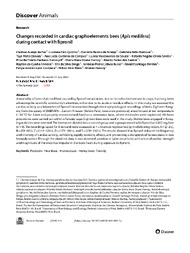Changes recorded in cardiac graphoelements bees (Apis mellifera) during contact with fipronil.
Changes recorded in cardiac graphoelements bees (Apis mellifera) during contact with fipronil.
Author(s): PAZ, C. A. da; EIRÓ-QUIRINO, L.; ARAÚJO, D. B. de; BARBOSA, G. B.; CÂMARA, T. M.; CAMPOS, A. L. C. de; SOUZA, L. V. de; SANTOS, R. N. O.; HARTCOPFF, P. F. P.; HAMOY, M. K. O.; SANTOS, M. F. dos; FERREIRA, R. da C.; DEIGA, Y. da S.; RUSSO, A. P. L.; PEREIRA, D. S.; CONTRERA, F. A. L.; MUTO, N. A.; HAMOY, M.
Summary: A mortality of bees (Apis mellifera) caused by fipronil intoxication, due to its indiscriminate use in crops, has long been attracting the scientific community’s attention, either due to its acute or residual effects. In this study, we assessed the cardiac activity as a biomarker of fipronil intoxication through electrophysiological recordings of bees. Eighteen foragers, from the apiary of EMBRAPA—Eastern Amazon (Belém-Pará), bees were previously anesthetized at low temperature (??10 °C) for 5 min and properly restrained and fixed on a stereotaxic base, where electrodes were implanted. All these procedures were carried out within a Faraday cage. Eighteen bees were used in the study. Worker bees engaged in foraging activities were selected. The bees were divided into a control group and a group treated with fipronil at 0.025 mg/bee (n?=?9). The recordings lasted for 4 min and were evaluated at 1-s intervals represented by the following letters: A?=?(2–3 s), B?=?(59–60 s), C?=?(119–120 s), D?=?(179–180 s), and E?=?(239–240 s). The results showed that fipronil reduced the frequency and intensity of cardiac activity, exhibiting rapidly evolving effects, and promoting a disruption of homeostasis in bee hemodynamics. Through the obtained data, it was observed variation in spike amplitude, with a loss of cardiac strength and magnitude of the electrical impulse in the bee’s heart during exposure to fipronil.
Publication year: 2024
Types of publication: Journal article
Unit: Embrapa Eastern Amazon
Keywords: Homeostasis, Honey bees, Pesticides, Toxicity
Observation
Some of Embrapa's publications are published as ePub files. To read them, use or download one of the following free software options to your computer or mobile device. Android: Google Play Books; IOS: iBooks; Windows and Linux: Calibre.
Access other publications
Access the Agricultural Research Database (BDPA) to consult Embrapa's full library collection and records.
Visit Embrapa Bookstore to purchase books and other publications sold by Embrapa.

